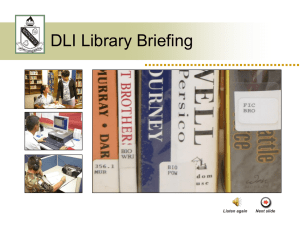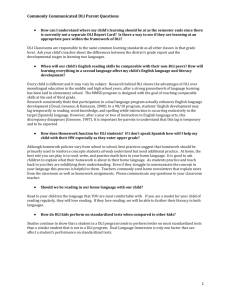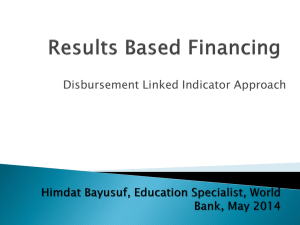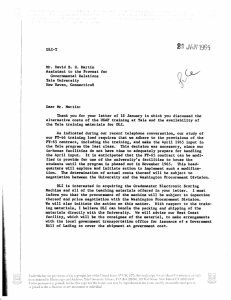Digital Library of India - IACS Institutional Repository
advertisement
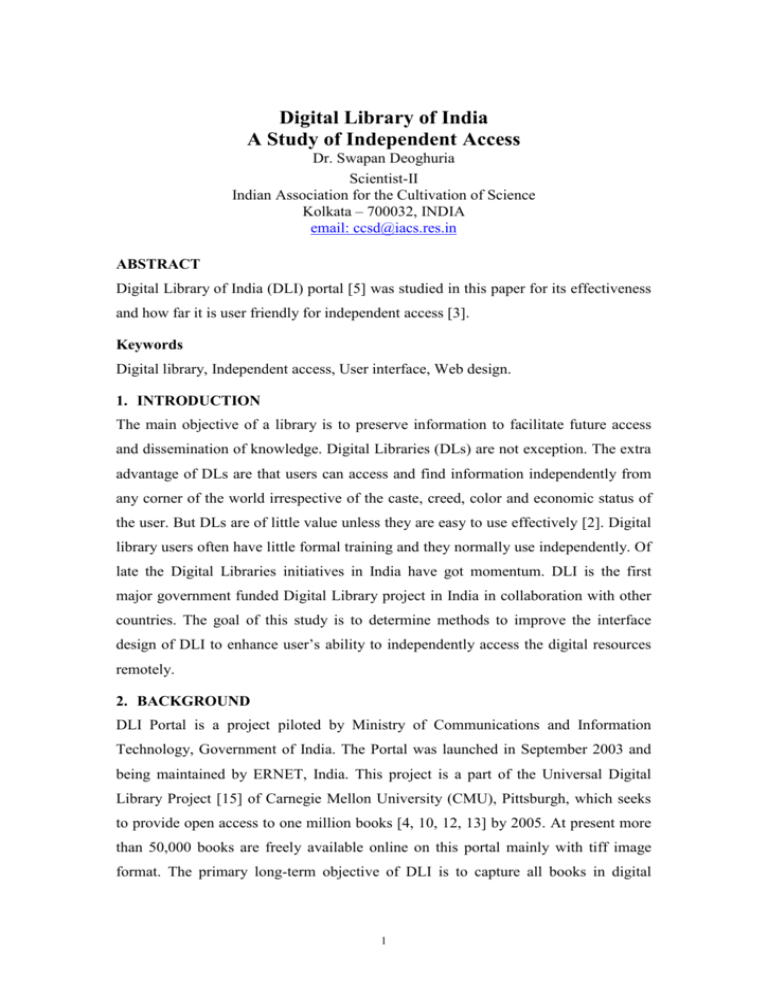
Digital Library of India A Study of Independent Access Dr. Swapan Deoghuria Scientist-II Indian Association for the Cultivation of Science Kolkata – 700032, INDIA email: ccsd@iacs.res.in ABSTRACT Digital Library of India (DLI) portal [5] was studied in this paper for its effectiveness and how far it is user friendly for independent access [3]. Keywords Digital library, Independent access, User interface, Web design. 1. INTRODUCTION The main objective of a library is to preserve information to facilitate future access and dissemination of knowledge. Digital Libraries (DLs) are not exception. The extra advantage of DLs are that users can access and find information independently from any corner of the world irrespective of the caste, creed, color and economic status of the user. But DLs are of little value unless they are easy to use effectively [2]. Digital library users often have little formal training and they normally use independently. Of late the Digital Libraries initiatives in India have got momentum. DLI is the first major government funded Digital Library project in India in collaboration with other countries. The goal of this study is to determine methods to improve the interface design of DLI to enhance user’s ability to independently access the digital resources remotely. 2. BACKGROUND DLI Portal is a project piloted by Ministry of Communications and Information Technology, Government of India. The Portal was launched in September 2003 and being maintained by ERNET, India. This project is a part of the Universal Digital Library Project [15] of Carnegie Mellon University (CMU), Pittsburgh, which seeks to provide open access to one million books [4, 10, 12, 13] by 2005. At present more than 50,000 books are freely available online on this portal mainly with tiff image format. The primary long-term objective of DLI is to capture all books in digital 1 format for better preservation and to make freely available to everybody through Internet for education, study and appreciation. This portal may provide a gateway to Indian Digital Libraries in science, arts, culture, music, movies, traditional medicine, palm leaves and many more. DLI project may also help other researchers who are working on improved scanning techniques, improved optical character recognition, and improved indexing. Books published before 1920 are non-copyrighted materials and being scanned for DLI project. DLI is also seeking permission from different publishers for books to be scanned which are considered best for academic purposes. There are 23 Indian and 8 Chinese organizations and CMU, USA are involved in this project. The Office of the Principal Scientific Advisor to the Government of India is funding the project in the Indian Institute of Science. The Ministry of Communication and Information Technology (MCIT) is funding the project at various partner centres of the Digital Library of India. Various centres have also pledged their local resources to make the DLI a reality. National Science Foundation (NSF), USA is providing funding for Scanners and Software research and development. Indian Institute of Science (IISc), Bangalore is coordinating the DLI project and also playing as research centre in India. Apart from IISc, other 22 partner centres were selected amongst academic institutions, religious and cultural institutions and government and research agencies. 3. METHODOLOGY The author tested the portal for its usability and user interface. Intel Pentium PCs with MS Windows (95, 98, 2000, XP) and 14”, 17” and 19” colour monitors and SGI Octane with 21” colour monitor were used. Netscape (4.7, 7.1) and IE (5.0, 6.0) browsers are used with 512 Kbps LAN connectivity. 4. USAGE AND USABILITY Digital resources are being mounted online at an enormous rate [9]. But effective use of these resources is being hampered, as there is no uniform and consistent way to find the useful materials existing over the Net [6]. Study of usage and usability of DLs are gaining importance day by day [1-3]. It is found [14] that both faculty and students use and like electronic resources and most easily adopt them if the sources are perceived as convenient, relevant, and time saving to their natural workflow. It is 2 also important for capacity planning, systems design, user support and strategic planning [7]. Digital information is useless unless the formats, protocols, and metadata are recognized and processed by the users. 4.1 How to Find Library people as well as researchers mainly rely on commercial search engines to find digital resources instead of their severe limitations [6]. “Google” and “Yahoo” search for the phrase “digital library of India” fetched 6,28,000 and 7,57,000 listings respectively. The exact phrase “digital library of India” fetched 234 and 293 listings through “Google” and “Yahoo” respectively by their advanced search. The first item was “Digital Library of India” with a link to the URL http://www.dli.ernet.in/vision.html for search through “Yahoo”. “Google” search gave two URLs namely www.dli.ernet.in/ and www.dli.gov.in/. The second URL does not show anything. Earlier the author found content in www.dli.gov.in/ site of DLI but nothing is available now. 4.2 Consistency Consistency in appearance, in control and in function is important for users. Users try to understand what the computer system is doing when they see certain results on the screen. They should be able to interrupt or reverse actions. Moreover error handling should be simple and easy to comprehend. DLI collections are not accessible in lower version of browsers (Netscape 4.7 and IE 5.0). There is no error message and no information about the software and hardware requirements to access the books. There is no link to contact the Webmaster for any queries or any suggestion. At the bottom of the left side of the page there is the counter that is visible only in 19” or larger monitor. Search facility is available to find digital contents through some key words. But if search result exceeds 100 listings, only the first 100 are visible. The “Next” link to show the next search results is not working. There is one “Advanced Search” facility that is not working with any browser. “Advanced Search” and “Fifty Thousand Books so Far” are blinking in Netscape Browser but static in IE. There are fourteen linked items like “Vision”, “Mission” etc. below the search window that provide useful information about the portal. Some of the items at the extreme right are not visible in smaller monitors. The item at the extreme right that is “Members Area” 3 opens a Login screen for entering user name and password. Some basic information should be provided for general users. Interestingly, these items are not appearing even in 21” monitor for lower version of browsers. Below these items there are two frames. Under the heading “Collections” there is a link “Related Projects” that is not consistent with other linked items and not related with any type of collections. The link “Related Projects” show two linked items namely “Example Based Machine Translation” and “Indian Language Transliteration Tool”. The first one opens a page with the heading “Machine Translation (Experimental Setup)” and a login prompt appears that asks for username. The author failed to login as guest. The system does not show any error message or any clue. There should be some basic information about this page regarding its purpose. The second link opens a new page about “Indian Language Transliteration” developed by IISc and CMU with different links for downloading the software and other utilities. 4.3 User Interface A digital library is only as good as its interface. Good support for users through elegant design, appropriate functionality and responsive systems make a difference in its effectiveness of digital libraries. When a system is hard to use, the users may not be attracted towards its contents how valuable they might be. Any digital library must assume that users will have a variety of computers, with a variety of OS and environments. In India majority of users still use 14” monitors. But the information of DLI on 14” monitor is not easy to read. The items on the right side and at the bottom of the page are neither appearing nor even scrollable. Even users have to scroll to read the information appearing in the main frame. All information of DLI is clearly visible in 19” or larger monitor. Frames have been used for the home page of DLI. The top frame contains logo in the left, title in the middle and scanned image of books in the right that is not visible in 14” and 17” monitors. Under the title there are two lines of text regarding host of this portal. This lengthy information can be avoided in the home page and should be linked to other page of the portal without the abbreviations (PSA and MCIT). Fortunately these abbreviations are not used in the linked page of “New User Interface” available at the bottom of the home page under the heading of “New Links”. Below this top frame lie the most important items of the portal that is the tools of finding the digital contents of the DLI. One can find the content either from 4 alphabetically sorted list of Authors or Titles of the contents. But the alphabetically sorted list of Authors are not according to the last name of the authors as claimed by the portal because “Rabindranath Tagore” is available under the alphabet “R” and not under the alphabet “T”. Also ‘Sir Rabindranath Tagore” is found under the alphabet “S”. The author also found “Ravindranath Tagore”, “Raveendranadha Tagur” in the list. There are five linked items namely Books, Journals, Palm Leaves, Books From CMU, Related Projects under the heading Collections at the top of the left frame. The link “Books” opens a separate page with some linked items about different category of books like Engineering, General etc. This list is also available in the right frame. These books are not available through key word search, browse by author or browse by title available in the home page. Also the window opened by this collection of books is not same as the window opened by browse by author or title or through keyword search. There is no zoom facility with this page and also format and other tools are kept at the bottom of the page that are not easily visible with small monitors. There are two categories under this list namely “Indian Institute of Science Collections” and “Books from other centres” make no sense to general users as other categories are mainly related with subjects. “Indian Institute of Science Collections” is organisied into some categories. But the categories are not systematic. There is a list of books under the category “Other Languages” without mentioning the specific languages of those books. Unfortunately words of the titles are connected with underscore character and very difficult to read. The collection of eight scanning centres is available under the link “Books from other centres”. Journals available are mainly published by Indian Academy of Science, Bangalore and also available in the right frame. The last item under “Journals” that is “Scientific Books” opens a page with the following text in the title area <font face=“Arial” size=”2”> along with the heading “Universal Digital Library, Hosted by Indian Institute of Science” and a list of books published by Indian Academy of Science. Scanned images of palm leaves under the link “Palm Leaves” are available from Anna University. Proper summary information about these palm leaves along with the images would be more useful to researchers. “Books From CMU” are alphabetically sorted with a scope to go to the top after each alphabet. There are six time periods (1850 – 1950) under the heading “Rare Collections” with hyperlinks. 5 The collections are organised according to the scanning centres. The heading “Scanning Centres” will pop-up 16 participating centres from where books are being scanned and the collections of a particular centre are supposed to appear once selected. Some of the centres like IIIT-Allahabad, Kanchi University, Maharashtra Industrial Development Corporation (MIDC), Punjab Technical University, Rashtrapathi Bhavan, Sringeri Mutt have scanned books but those are not available on the portal till now. IIIT-Hyderabad Centre has scanned 12409 numbers of books so far and those data are supposed to be made available on the server by June 2004 as shown in the page. Till November 11, 2004 those are not available and DLI did not update the information. IISc collections are same as available under “Books” under the heading “Collections”. Arulmigu Kalasligam College of Engineering (AKCE) collections are alphabetically sorted but not organised according to subject or language. Collection of Anna University is Palm Leaves same as available under “Collection”. City Central Library, Hyderabad collections are organised according to different languages namely Telugu, English and Urdu. Unfortunately the words of the titles are clubbed together and very difficult to understand. For example, the first entry under English language is “Amanualoftheprinciplesofequity”. It should be “A manual of the principles of equity”. Similarly, Tirumala Tirupati Devasthanams, Tirupati collections are ordered according to language namely English, Kannada, Sanskrit, Tamil and Telugu. Alphabetically sorted list of books appear after clicking on a language link. Words of the titles are clubbed together here also. For example, the first entry under English is “Adialogueonprinciplesandpracticeofhinduism”, that should be “A dialogue on principles and practice of hinduism”. This is a serious problem. Indian Institute of Astrophysics, Bangalore collections are alphabetically sorted but the last two entries are not ordered. Books are not categorised according to subject or language. University of Pune, Maharashtra collections are organised according to different subjects and under each subject the list is alphabetically sorted. Shanmugha Art, Science, Technology & Research Academy (SASTRA), Tanjavur, Tamil Nadu collections are divided into books from SASTRA and books from CMU by SASTRA. Again each link is alphabetically arranged. State Central Library, Hyderabad does not show their collections but a different page with heading “Books From Other Centres” 6 with a list of Scanning Centres including State Central Library (SCL), Hyderabad. This link is also available under the link “Books” under the heading ‘Collections” discussed earlier. The collections from this centre are not arranged in any way and there is a number before each title of the book that makes more difficult to understand. For example, the first two entries are “0163s Plays Pleasant And Un Pleasant” and “0212s On Compromise”. SV Digital Library is the only centre that is not available under the heading scanning centres. Under the heading “Languages” there are six languages namely English, Kannada, Sanskrit, Tamil, Telugu and Urdu. Except Urdu all other languages show the collections of Tirumala Tirupati Devasthanams, Tirupati. The Urdu collections are from City Central Library, Hyderabad. Unfortunately there is no space between the words of the titles of the books and difficult to read. Under the heading “New Links” there are three items namely “UDL-Talks”, “New User Interface” and “DLI-Status-Report”. The presentations on May 2004 meeting are listed in “UDL-Talks” link. “DLI-StatusReport” gives a summary of information on status of all participating centres of DLI. “New User Interface” link opens a new home page of DLI with improved search facility for books with title, author, subject, year, language and scanning centre. Search for author “Rabindranath Tagore”, “Rabindranath” and “Tagore” matches 0, 21 and 32 results respectively. It is not clear why “Rabindranath Tagore” did not match any entry. Also there are eight entries for the title “Crescent Moon” by “Rabindranath Tagore” with different page numbers. Out of eight only two show the actual book. One entry with 304 pages is not available on the server. Others entries are Thomas Carlyle with 252 pages, Lucretia by Lord Lytton with 429 pages, On Compromise by John Morley with 289 pages, The Art of Literature with Arthur Schopenhauer with 151 pages, Behind the Bungalow by Eha with 207 pages. The search result is more meaningful here as essential metadata is available for each entry. But this type of wrong entry should be avoided. Under “DLI Collections” there are four headings namely “Book Collections”, “Journals”, “News Papers” and “Manuscripts”. There is no link for the items under “Journals” and “Manuscripts”. Under “Book Collections” three scanning centres are hyperlinked. No hyperlink is available for the word “more...” but users generally expect that. Only the metadata for the collection of “Rastrapati Bhavan” is available at present. Alphabetically sorted 7 list of titles of books are available under the heading “Title Beginning With:” “Authors Last Name” for listing of authors with alphabetically sorted form is not working. The second page is always same for any alphabets. One can browse the books year wise under the heading “Year”. Under the heading “Subject” there are nine subjects on the page and a link “More...” with many more subjects. There are nine languages namely English, Bengali, Hindi, Kannada, Marathi, Sanskrit, Tamil, Telugu and Urdu. For Bengali language all entries are appearing and it seems that there is no Bengali collection on DLI. In the search window there are more languages available apart from those available on the page. There is a scope to send feedback by the users that is not available on the original home page. “New User Interface” link gives organised data and easy to use independently. Meta data of the resources should be updated to minimise duplication and wrong entry. 4.4 Navigation The author first used the keyword “Rabindranath Tagore”, the only Nobel Laureate in India in literature. There are 25 records in the list with the headings Serial No. (#), Score, Matches, Creator(s) and Title. Language should be included as one of the heading because many titles of DLI can be in regional languages. The numbers within brackets in Matches indicate mow many times the key word matches with the document text and with the metadata. One can browse any title directly from this list. It opens a separate page with scanned image of the first page of the book with tools like Next Page, Previous Page, Zoom-in, Zoom-out, Format (TXT, PTIFF, HTM) and Go to Page (within the range of the pages of the book). The design of the page is good and easy to use. “‘GORA-RAVINDRA NATH TAGORE” title by Sri Venkata Parvatishwara Kavi was found twice. Probably these are duplicate records. Moreover the scanned images show that the book is written in another Indian language and may be a translation from the original. This poses a serious problem to users because there is no way to know about the subject or language of the books from the list itself. Books available in regional languages are of no use to users who do not know that language unless transliteration of the same book is available in other regional languages as well as in English. It may be convenient to users if each title is represented by summary information that conveys its essence. In a conventional 8 library contents are organized by classification or by ordering. Library professionals help users to search and access materials on the basis of catalogs and index cards. Only PTIFF format is working for regional language resources. The other two formats (TXT and HTML) should not appear where resources on these formats are not available. Most digital library users still print out articles that are judged useful as no one wants to read them online and a printing format such as PDF is popular. But in DLI there is no scope to print out a particular resource in a single mouse click. Probably DLI does not want systematic downloading of its resources. Categorization of resources under different languages and different subjects is a must for effective use. 4.5 Contents DLI Status Report shows all participating centres have scanned total 87,369 books so far. Out of those IISc received 55,570 books and 48,779 books are available on the Web. The remaining 6,791 books are under processing. Home page of DLI shows contents available in six languages including English. But “New User Interface” link shows contents are available in twelve languages. There are some collections under the category “Other Language”. May be these are in some foreign languages. Contents are not selected from all regional Indian languages to justify the name of the portal. Participating organizations are not selected from all states or regions of India. Of course there is a guideline for interested organizations/ persons to participate in DLI project. Till date the National Library of India is not included in this project that is advocated in Universal Library Project. 5. LIMITATIONS a. DLI portal is browser dependent. Users are not warned that the contents cannot be accessed through all browsers. b. Too many items in the home page to choose. Some information are available more than once. c. The databases of digital contents are not easy to use independently. d. All items in a page are not appearing for small monitors. e. The information appearing on screen is not easy to read in small monitors. f. All digital resources are not categorized according to subjects and languages. 9 g. There is no scope to print the digital resources easily. h. Some duplicate and wrong data exist. i. Representation of all Indian languages and states are absent. j. Short notes on digital resources are not available. k. There are items in the page where hyperlinks are expected but not available. l. There are hyperlinks for certain items but the links are not accessible. 6. FURTHER SCOPE Many STM journals are published from India by nonprofit organizations. Majority of them are not in a position to publish the same online mainly due to lack of technical expertise. Also the very existence of these journals is at risk due to tough competition from large commercial publishers. At present only journals published by Indian Academy of Science can be accessed from this portal. Journals published by other Societies and non-profit making organisations can be included for online access through DLI. Approximately 8,000 to 10,000 Ph. D. theses are being generated annually from Indian universities [11]. But majority of them are not accessible. DLI can play a host to archive these electronic theses and dissertations for easy access and dissemination of knowledge. For both cases the contents are born digital and would not be a problem for DLI. 7. CONCLUSIONS Existing archives of paper have many shortcomings but digital information is also very hard to preserve [8]. Sustainability is an important issue for this type of project as it involves huge fund as well as trained manpower. Being aware of these shortcomings DLI can still play an important role in free access to information globally. The “New User Interface” is more users friendly and data available are more organised. We hope DLI will shift to this user interface in near future. Within a short period of time DLI has done a commendable job and we hope many of the limitations mentioned in this paper will be considered to make it more user friendly for effective use in near future. 10 8. ACKNOWLEDGMENTS The author would like to thank Department of Science and Technology (DST), Government of India for using the computer facilities available at Indian Association for the Cultivation of Science, Kolkata under ICOSER project for this study. 9. REFERENCES [1] ARL. (2002). Collections & Access for the 21st-Century Scholar: Changing Roles of Research Libraries. A Report from the ARL Collections & Access Issues Task Force. ARL Bimonthly Report 225 (December 2002). [2] Arms, Y. W. (2000). Digital Libraries. The MIT Press, Cambridge, Massachusetts, London, England, pp 143. [3] Carole A. G. (2003). A Study of Independent Access to Library Resources: Follow-up Study of LibQual+ Survey of Library Service Quality – Personal Control Domain. Carnegie Mellon University Libraries, Digital Library Initiatives. May 13, 2003. URL: www.library.cmu.edu/Libraries/LibQualPersonalControl.pdf (Accessed on 11.11.2004) [4] Covey, D. T. (2003). Understanding and Assessing the Million Book Project. Pennsylvania Library Association, October 5, 2003. URL: http://www.library.cmu.edu/Libraries/MBPfinalNo_PICTS.ppt (Accessed on 11.11.2004) [5] Digital Library of India. A Portal at Ministry of Communications and Information Technology, Government of India. URL: www.dli.ernet.in/ (Accessed on 11.11.2004) [6] DLF. A New Approach to Finding Research Materials on the Web. URL: www.diglib.org/architectures/vision.htm (Accessed on 10.11.2004) [7] Greenstein, D. and Covey, D. T. (2000). Usage, Usability and User Support. Report of a discussion group convened at the DLF Forum on 2 April 2000. 11 [8] Lawrence, G. W., Kehoe, W. R., Rieger, O. Y., Walters, W. H., and Kenney, A. R.( 2000). Risk Management of Digital Information: A File Format Investigation. A Council on Library and Information Resources Publication, (June 2000) [9] Lyman, P. and Hal, R. V. (2003). How Much Information? Regents of the University of California, October 27, 2003. URL: www.sims.berkeley.edu/research/projects/how-much-info-2003. (Accessed on 10.11.2004) [10] Million Book Project FAQ. (2004). URL: www.library.cmu.edu/Libraries/MBP_FAQ.html (Accessed on 10.11.2004). [11] Nandi, A. and Satpathi, J. N. (2003). Electronic Theses and Dissertations (ETD) – New Genera of Documents in Digital Environment. Proceedings of the XXIV All India Conference of IASLIC (Survey of India, Dehradun, India, December 15-18, 2003). IASLIC, Kolkata, 2003 35-39. [12] St. Clair, G. (2003). Million Book Project Today. At OCLC, October 21, 2003. URL: www.library.cmu.edu/Libraries/MillionBook_OCLC.ppt (Accessed on November 10, 2004). [13] St. Clair, G. (2003). Million Book Project in U.S. and India. At International Conference on the Future of the Book, Cairns, Australia, April 22, 2003. URL: www.library.cmu.edu/People/gstclair/presentations.html [14] Tenopir, C. (2003). Use and Users of Electronic Library Resources: An overview and Analysis of Recent Research Studies. A Council on Library and Information Resources Publication, August 2003 [15] Universal Library Project. 2004. URL: www.ulib.org/ (Accessed on 10.11.2004). 12
